Unit 3 Food and Culture-Reading and Thinking 课件 人教选必二
文档属性
| 名称 | Unit 3 Food and Culture-Reading and Thinking 课件 人教选必二 | 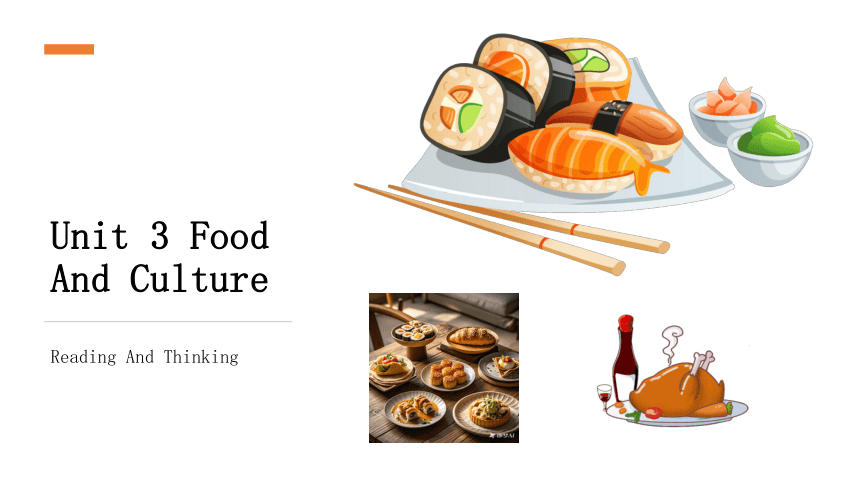 | |
| 格式 | pptx | ||
| 文件大小 | 176.3MB | ||
| 资源类型 | 试卷 | ||
| 版本资源 | 人教版(2019) | ||
| 科目 | 英语 | ||
| 更新时间 | 2024-12-11 08:36:20 | ||
图片预览

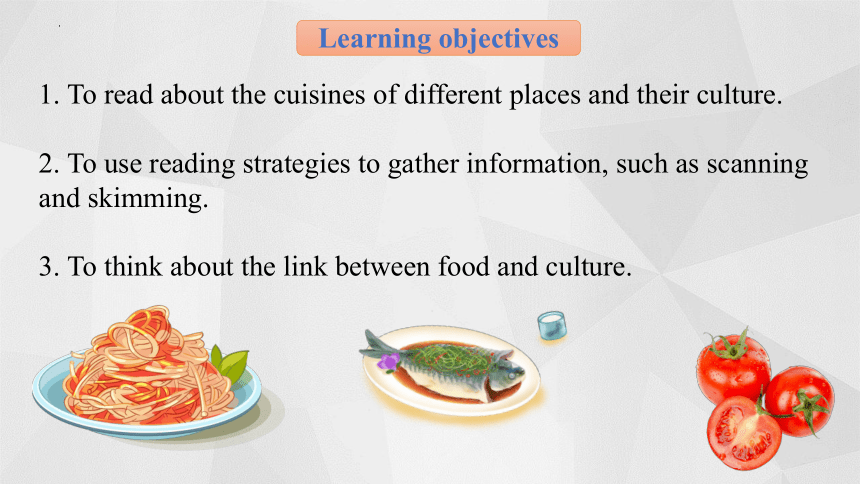
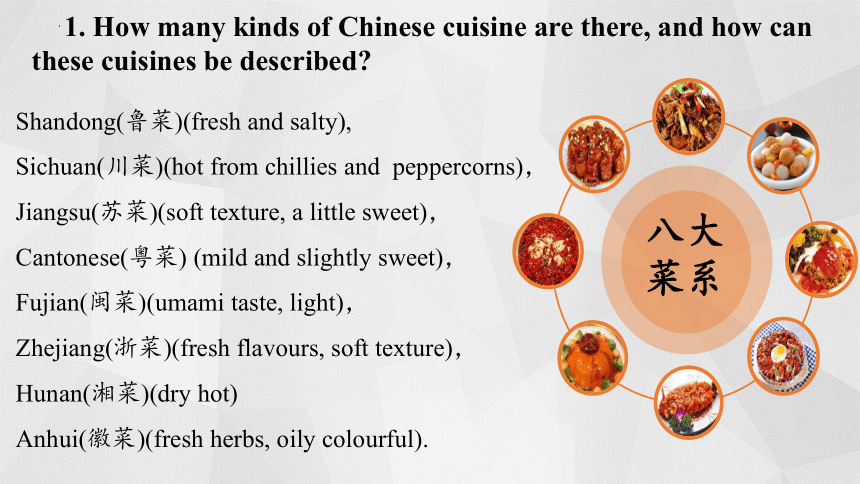
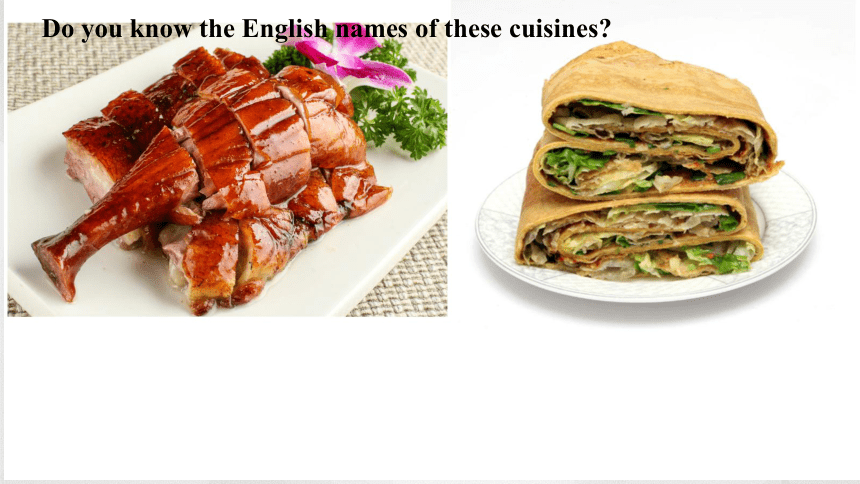
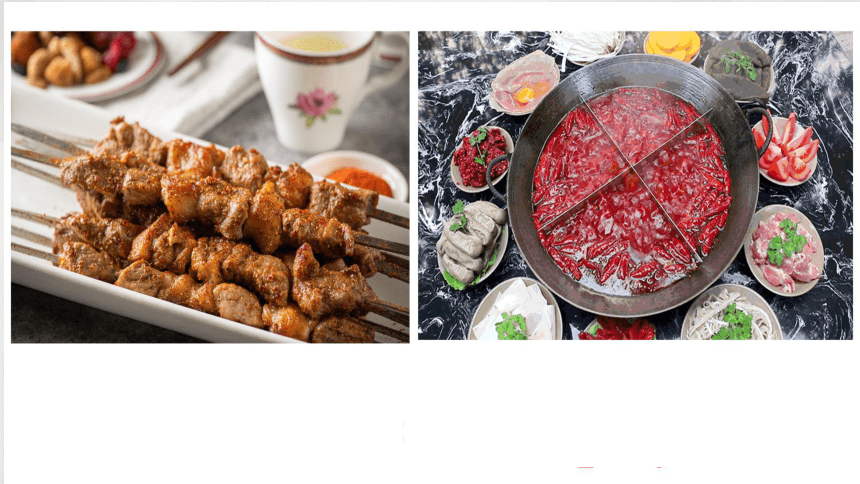
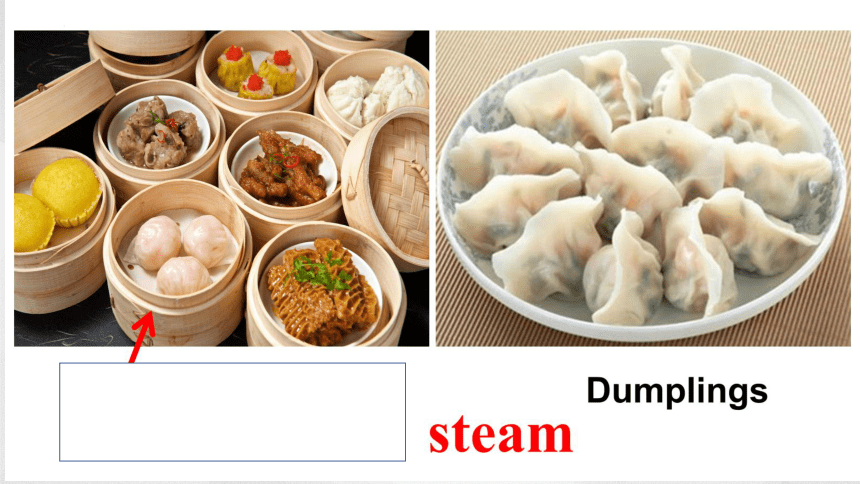
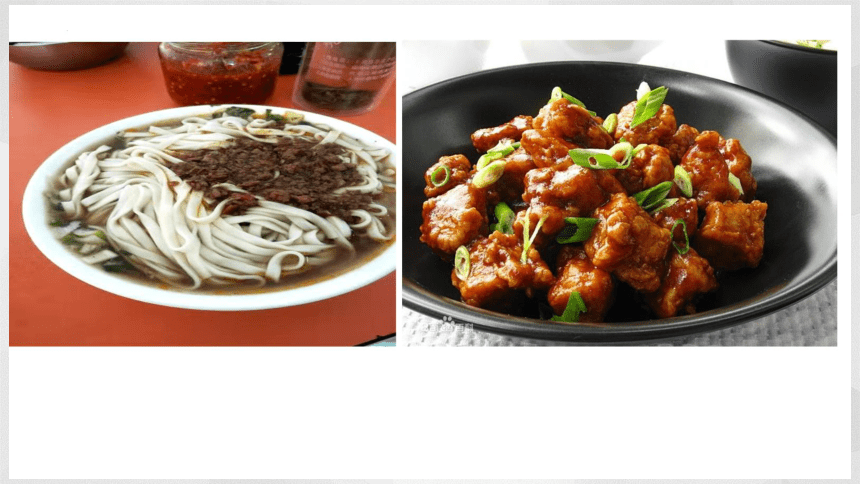
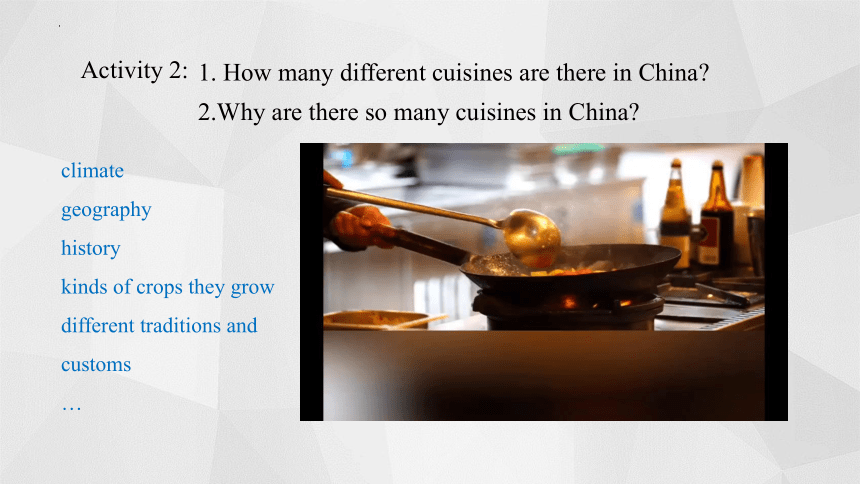
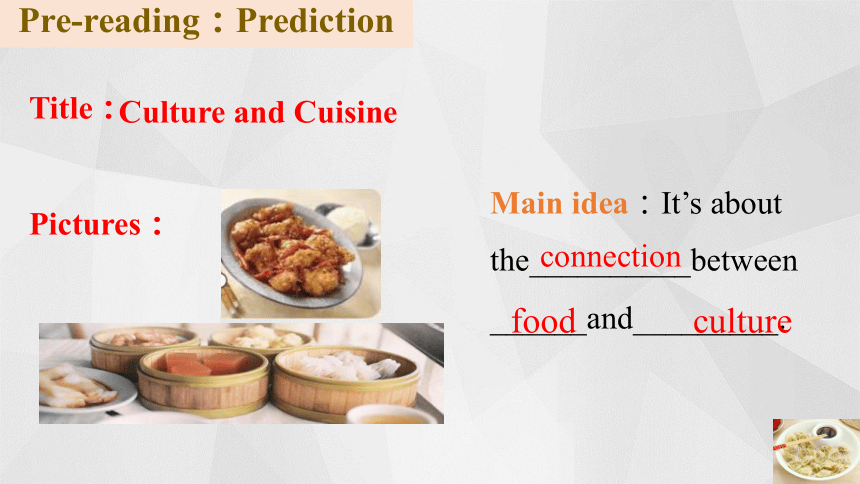
文档简介
Unit 3 Food And Culture
Reading And Thinking
Learning objectives
1. To read about the cuisines of different places and their culture.
2. To use reading strategies to gather information, such as scanning and skimming.
3. To think about the link between food and culture.
八大
菜系
1. How many kinds of Chinese cuisine are there, and how can these cuisines be described?
Shandong(鲁菜)(fresh and salty),
Sichuan(川菜)(hot from chillies and peppercorns),
Jiangsu(苏菜)(soft texture, a little sweet),
Cantonese(粤菜) (mild and slightly sweet),
Fujian(闽菜)(umami taste, light),
Zhejiang(浙菜)(fresh flavours, soft texture),
Hunan(湘菜)(dry hot)
Anhui(徽菜)(fresh herbs, oily colourful).
Do you know the English names of these cuisines?
bamboo steamer
1. How many different cuisines are there in China?
2.Why are there so many cuisines in China?
Activity 2:
climate
geography
history
kinds of crops they grow
different traditions and customs
…
Title:
Pictures:
Pre-reading:Prediction
Main idea:It’s about the__________between ______and_________.
food culture
Culture and Cuisine
connection
Read for structures
Para. 1 You are _____________.
Para. 2 Chinese food in __________.
Para. 3 Chinese food in __________.
Para. 4 Chinese food in __________.
Para. 5 Chinese food in __________.
Para. 6 Chinese food in ____________
______________.
Para. 7 Culture and cuisine _____________.
what you eat
America
Beijng
Shangdong
Xinjiang
Guangdong
and Henan
go hand in hand
How is the passage developed?
Topic: You are what you eat
Chinese food in America
Chinese food in Beijing
Chinese food in Shangdong
Chinese food in Xinjiang
Chinese food in Gunagdong&
Henan
Conclusion: culture and cuisine go hand in hand
While-reading
“You are what you eat.”
What does the quote mean ?
What we eat reflects personality, character and culture.
Why does the author quote Jean’s words at the beginning?
To introduce the topic of the passage.
Para 1
What does the idiom “a case in point” most probably mean?
A.A good idea.
B.A proper example.
C.A right decision.
D.A reasonable suggestion.
Certainly, in many ways this seems to be true. Chinese cuisine is a case in point.
√
Para 2
Certainly, in many ways this seems to be true. Chinese cuisine is a case in point. Prior to coming to China, my only experience with Chinese cooking was in America, with Chinese food that had been changed to suit American tastes. For example, America’s most popular Chinese dish is General Tso’s chicken, which consists of fried chicken covered in a sweet sauce, flavoured with hot red peppers. This is probably not an authentic Chinese recipe, however, it cannot tell us much about the Chinese. On the other hand, it does tell us a lot about Americans. It tells us, for example, that Americans love bold, simple flavours. And, since the dish was also invented recently, it tells us that Americans are not afraid to try new foods.
Q1. What is the most popular Chinese food in America?
Q2. Is it an authentic(真正的) Chinese food? Why?
Q3. What can the dish tell us about Americans?
Paragraph 2
No, it had been changed to suit American tastes.
It tells us that Americans love bold(浓烈的,英勇的), simple flavours and are not afraid to try new foods.
Main idea: the experience with Chinese food in America.
Later I had a chance to experience authentic Chinese food by coming to China. When my family and I had just arrived in China, we went looking for a good place to eat in Beijing. A Sichuan restaurant had been recommended to us by a friend, and finally, we found it. Tired, hungry, and not knowing a word of Chinese, we had no idea how to order, so the chef just began filling our table with the best food we had ever eaten. With this, we had the pleasure of experiencing an entirely new taste: Sichuan peppercorns. The food was wonderful and different, but what was even more important was the friendship offered us.
Q1. In Beijing, where did the author and the family enjoy the Chinese food?
Q2. What is the result of the writer having no idea how to order food?
Q3. Did Sichuan food taste the same in Beijing?
Main idea: the experience with Sichuan cuisine in Beijing
Paragraph 3
We soon moved to Shandong Province in the eastern part of North China. My favourite dish there was boiled dumplings served with vinegar. I observed that family is important to the people there. It has become a favourite traditional dish of the people in North China, where making dumplings has always been a family affair with everyone---from the youngest to the oldest---joining in to help. Later, I learnt that the most famous food in Shandong is pancake rolls stuffed with sliced Chinese green onions.
Q1. What is the favourite traditional dish and famous fish of the people in North China?
Q2. What can the dish tell us about the people there?
Main idea: the experience with Shandong cuisine in Shandong.
Paragraph 4
dumplings and pancakes rolls.
Family is important to the people there.
Then we moved to northern Xinjiang. Some of our friends were Kazak and Inner Mongolian. These groups traditionally wandered the open range on horses. As a result, their traditional foods are what you can cook over an open fire---usually boiled or roasted meat, such as lamb kebab.
Q1. What is the favourite traditional dish of the people in North China?
Q2. Why do people in North China have this kind of food?
Main idea: the experience with northwest China cuisine in Xinjiang.
Paragraph 5
cause
effect
Because these groups traditionally wandered the open range on horses.
Their traditional foods are what you can cook over an open fire.
Our travels then took us to South China, and then on to central China. In each place we went, we experienced wonderful local dishes, from Guangdong’s elegant dim sum---small servings of food in bamboo steamers---to the exceptional stewed noodles in Henan. Everywhere, the food was as varied as the people. However, one thing is always true: Through food, Chinese people everywhere show friendship and kindness.
Q1. What kind of Chinese dishes did the author enjoy in South China and Central China?
Q2. What can we learn about Chinese through food?
Main idea: the experience with south and central China cuisine.
Paragraph 6
At a minimum, the kinds of food local people consume tell us what they grow in their region, what kinds of lives they lead, and what they like and do not like. Could we also say, for example, that those who like bold flavours are bold themselves? Or, that those who like spicy food tend to have a hot temper? Maybe. Maybe not. What we can say, however, is that culture and cuisine go hand in hand, and if you do not experience one, you can never really know the other.
Q1. What can the food local people consume tell us?
Q2. To sum up the main idea of paragraph 7.
It can tell us their region, their life, their preference.
Main idea: Culture and cuisine go hand in hand.
Paragraph 7
{5C22544A-7EE6-4342-B048-85BDC9FD1C3A}Place
Kind of Chinese food
Typical dish
People or culture
America
Chinese food__________
______American tastes
General Tso’s chicken
Americans love_______
_______flavors, and not afraid to try new foods
Beijing
_______________
dishes with______________
People there offered them good __________
Shandong
________________
____dumplings served with____; pancake rolls _____ with sliced Chinese green onions
__________is important to the people there.
Northwest China
Xinjiang and Inner
Mongolian cuisine
_______ or ______ meat, such as lamb kebab
...wandered the open range on ______...cook over an open _______
South China
Guangdong cuisine
_____________
Through food, Chinese people everywhere show_______________
Central China
Henan cuisine
______________
changed to
suit
bold,
simple
Sichuan cuisine
friendship
Sichuan peppercorns
Shandong cuisine
Family
Boiled
vinegar
stuffed
horses
Boiled
roasted
fire
Dim sum
Stewed noodles
friendship and kindness
Read para 2-6 again and complete the table below
In what order is the rest of the passage organized?
Time order
Post-reading
China
America
Beijng
Shangdong
Xinjiang
Guangdong
Henan
Place order
place clue
The passage is organized in the order of __________________
time+place
Do you think “culture and cuisine go hand in hand”?
Give your reasons.
Yes, because so much of a culture is based upon food and how it is eaten and served.
No, with the impact of globalization, all kinds of food are available everywhere, so food no longer reflects cultures.
In addition, in this fast-changing world, everything is changing, including cuisines.
Discussion
2. Imagine that it is true that people's personalities are closely linked to the foods they eat. What does eating the following foods tell you about a person?
spicy food vegetarian food junk food seafood sweets chocolate rice noodles onion garlic bacon ham sausage cabbage mushroom bean curd
Possibly, people who like spicy food love excitement and new experiences. And people who like junk food like to enjoy life without worrying about the future.
Discussion
The French author Jean Anthelme Brillat-Savarin once wrote, “Tell me what you eat, and I will tell you what you are,” 1. means “You are what you eat.” In fact, Brillat-Savarin was actually 2. (refer) to our personality, character, and culture. In many ways, this seems to be true. Chinese cuisine is a case in point. China is a country with vast 3._______(area) and a large population. So the food is as 4. _ (vary) as the people. For example, people in Shandong like boiled dumplings 5._______(serve) with vinegar, because the process of making dumplings can bring the family members together. 6. (traditional), people in Xinjiang spent most of their time on horse backs, and that is 7.____ they prefer their food to 8. __(cook) over an open fire. In conclusion, through food, Chinese people everywhere show their culture as well as their friendship and 9. (kind). So what we can say is that culture and cuisine go hand 10. hand, and if you do not experience one, you can never really know the other.
which
referring
areas
varied
served
Traditionally
why
be cooked
kindness
in
Test for goals
Reading And Thinking
Learning objectives
1. To read about the cuisines of different places and their culture.
2. To use reading strategies to gather information, such as scanning and skimming.
3. To think about the link between food and culture.
八大
菜系
1. How many kinds of Chinese cuisine are there, and how can these cuisines be described?
Shandong(鲁菜)(fresh and salty),
Sichuan(川菜)(hot from chillies and peppercorns),
Jiangsu(苏菜)(soft texture, a little sweet),
Cantonese(粤菜) (mild and slightly sweet),
Fujian(闽菜)(umami taste, light),
Zhejiang(浙菜)(fresh flavours, soft texture),
Hunan(湘菜)(dry hot)
Anhui(徽菜)(fresh herbs, oily colourful).
Do you know the English names of these cuisines?
bamboo steamer
1. How many different cuisines are there in China?
2.Why are there so many cuisines in China?
Activity 2:
climate
geography
history
kinds of crops they grow
different traditions and customs
…
Title:
Pictures:
Pre-reading:Prediction
Main idea:It’s about the__________between ______and_________.
food culture
Culture and Cuisine
connection
Read for structures
Para. 1 You are _____________.
Para. 2 Chinese food in __________.
Para. 3 Chinese food in __________.
Para. 4 Chinese food in __________.
Para. 5 Chinese food in __________.
Para. 6 Chinese food in ____________
______________.
Para. 7 Culture and cuisine _____________.
what you eat
America
Beijng
Shangdong
Xinjiang
Guangdong
and Henan
go hand in hand
How is the passage developed?
Topic: You are what you eat
Chinese food in America
Chinese food in Beijing
Chinese food in Shangdong
Chinese food in Xinjiang
Chinese food in Gunagdong&
Henan
Conclusion: culture and cuisine go hand in hand
While-reading
“You are what you eat.”
What does the quote mean ?
What we eat reflects personality, character and culture.
Why does the author quote Jean’s words at the beginning?
To introduce the topic of the passage.
Para 1
What does the idiom “a case in point” most probably mean?
A.A good idea.
B.A proper example.
C.A right decision.
D.A reasonable suggestion.
Certainly, in many ways this seems to be true. Chinese cuisine is a case in point.
√
Para 2
Certainly, in many ways this seems to be true. Chinese cuisine is a case in point. Prior to coming to China, my only experience with Chinese cooking was in America, with Chinese food that had been changed to suit American tastes. For example, America’s most popular Chinese dish is General Tso’s chicken, which consists of fried chicken covered in a sweet sauce, flavoured with hot red peppers. This is probably not an authentic Chinese recipe, however, it cannot tell us much about the Chinese. On the other hand, it does tell us a lot about Americans. It tells us, for example, that Americans love bold, simple flavours. And, since the dish was also invented recently, it tells us that Americans are not afraid to try new foods.
Q1. What is the most popular Chinese food in America?
Q2. Is it an authentic(真正的) Chinese food? Why?
Q3. What can the dish tell us about Americans?
Paragraph 2
No, it had been changed to suit American tastes.
It tells us that Americans love bold(浓烈的,英勇的), simple flavours and are not afraid to try new foods.
Main idea: the experience with Chinese food in America.
Later I had a chance to experience authentic Chinese food by coming to China. When my family and I had just arrived in China, we went looking for a good place to eat in Beijing. A Sichuan restaurant had been recommended to us by a friend, and finally, we found it. Tired, hungry, and not knowing a word of Chinese, we had no idea how to order, so the chef just began filling our table with the best food we had ever eaten. With this, we had the pleasure of experiencing an entirely new taste: Sichuan peppercorns. The food was wonderful and different, but what was even more important was the friendship offered us.
Q1. In Beijing, where did the author and the family enjoy the Chinese food?
Q2. What is the result of the writer having no idea how to order food?
Q3. Did Sichuan food taste the same in Beijing?
Main idea: the experience with Sichuan cuisine in Beijing
Paragraph 3
We soon moved to Shandong Province in the eastern part of North China. My favourite dish there was boiled dumplings served with vinegar. I observed that family is important to the people there. It has become a favourite traditional dish of the people in North China, where making dumplings has always been a family affair with everyone---from the youngest to the oldest---joining in to help. Later, I learnt that the most famous food in Shandong is pancake rolls stuffed with sliced Chinese green onions.
Q1. What is the favourite traditional dish and famous fish of the people in North China?
Q2. What can the dish tell us about the people there?
Main idea: the experience with Shandong cuisine in Shandong.
Paragraph 4
dumplings and pancakes rolls.
Family is important to the people there.
Then we moved to northern Xinjiang. Some of our friends were Kazak and Inner Mongolian. These groups traditionally wandered the open range on horses. As a result, their traditional foods are what you can cook over an open fire---usually boiled or roasted meat, such as lamb kebab.
Q1. What is the favourite traditional dish of the people in North China?
Q2. Why do people in North China have this kind of food?
Main idea: the experience with northwest China cuisine in Xinjiang.
Paragraph 5
cause
effect
Because these groups traditionally wandered the open range on horses.
Their traditional foods are what you can cook over an open fire.
Our travels then took us to South China, and then on to central China. In each place we went, we experienced wonderful local dishes, from Guangdong’s elegant dim sum---small servings of food in bamboo steamers---to the exceptional stewed noodles in Henan. Everywhere, the food was as varied as the people. However, one thing is always true: Through food, Chinese people everywhere show friendship and kindness.
Q1. What kind of Chinese dishes did the author enjoy in South China and Central China?
Q2. What can we learn about Chinese through food?
Main idea: the experience with south and central China cuisine.
Paragraph 6
At a minimum, the kinds of food local people consume tell us what they grow in their region, what kinds of lives they lead, and what they like and do not like. Could we also say, for example, that those who like bold flavours are bold themselves? Or, that those who like spicy food tend to have a hot temper? Maybe. Maybe not. What we can say, however, is that culture and cuisine go hand in hand, and if you do not experience one, you can never really know the other.
Q1. What can the food local people consume tell us?
Q2. To sum up the main idea of paragraph 7.
It can tell us their region, their life, their preference.
Main idea: Culture and cuisine go hand in hand.
Paragraph 7
{5C22544A-7EE6-4342-B048-85BDC9FD1C3A}Place
Kind of Chinese food
Typical dish
People or culture
America
Chinese food__________
______American tastes
General Tso’s chicken
Americans love_______
_______flavors, and not afraid to try new foods
Beijing
_______________
dishes with______________
People there offered them good __________
Shandong
________________
____dumplings served with____; pancake rolls _____ with sliced Chinese green onions
__________is important to the people there.
Northwest China
Xinjiang and Inner
Mongolian cuisine
_______ or ______ meat, such as lamb kebab
...wandered the open range on ______...cook over an open _______
South China
Guangdong cuisine
_____________
Through food, Chinese people everywhere show_______________
Central China
Henan cuisine
______________
changed to
suit
bold,
simple
Sichuan cuisine
friendship
Sichuan peppercorns
Shandong cuisine
Family
Boiled
vinegar
stuffed
horses
Boiled
roasted
fire
Dim sum
Stewed noodles
friendship and kindness
Read para 2-6 again and complete the table below
In what order is the rest of the passage organized?
Time order
Post-reading
China
America
Beijng
Shangdong
Xinjiang
Guangdong
Henan
Place order
place clue
The passage is organized in the order of __________________
time+place
Do you think “culture and cuisine go hand in hand”?
Give your reasons.
Yes, because so much of a culture is based upon food and how it is eaten and served.
No, with the impact of globalization, all kinds of food are available everywhere, so food no longer reflects cultures.
In addition, in this fast-changing world, everything is changing, including cuisines.
Discussion
2. Imagine that it is true that people's personalities are closely linked to the foods they eat. What does eating the following foods tell you about a person?
spicy food vegetarian food junk food seafood sweets chocolate rice noodles onion garlic bacon ham sausage cabbage mushroom bean curd
Possibly, people who like spicy food love excitement and new experiences. And people who like junk food like to enjoy life without worrying about the future.
Discussion
The French author Jean Anthelme Brillat-Savarin once wrote, “Tell me what you eat, and I will tell you what you are,” 1. means “You are what you eat.” In fact, Brillat-Savarin was actually 2. (refer) to our personality, character, and culture. In many ways, this seems to be true. Chinese cuisine is a case in point. China is a country with vast 3._______(area) and a large population. So the food is as 4. _ (vary) as the people. For example, people in Shandong like boiled dumplings 5._______(serve) with vinegar, because the process of making dumplings can bring the family members together. 6. (traditional), people in Xinjiang spent most of their time on horse backs, and that is 7.____ they prefer their food to 8. __(cook) over an open fire. In conclusion, through food, Chinese people everywhere show their culture as well as their friendship and 9. (kind). So what we can say is that culture and cuisine go hand 10. hand, and if you do not experience one, you can never really know the other.
which
referring
areas
varied
served
Traditionally
why
be cooked
kindness
in
Test for goals
